A very difficult question since it depends on the grades, colors and weight. The cheapest ones
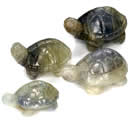 are the simple processed sapphires since their processing add more value than the original sapphire value. Their price is in the range from USD 10-20 per piece.
are the simple processed sapphires since their processing add more value than the original sapphire value. Their price is in the range from USD 10-20 per piece.
The second scale corresponds to the cab sapphires, with few cuttings since their transparency is not enough. Their processing adds more value than their original value. Those can be found in blue and green. Their price tends to be non related to their size. Their price is around USD 10 per carat.
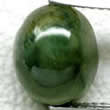
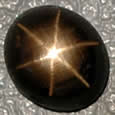
Star sapphires can be found in Thailand with black and golden colors. The blue ones are obtained after processing with titanium. Their prices are USD 10 per carat.
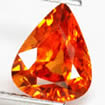 Next we have the sapphires with multi-faces. The cheapest ones have lower size, additions to the material or are treated with berilum. Their prices ranges from USD 20 per carat and increase according to size and color. Those with more than 1 carat and treated with beryllium (to yield a green color) are priced at USD 75 per carat. Those with yellow and orange-red colors are priced from USD 100 to USD 120 per carat.
Next we have the sapphires with multi-faces. The cheapest ones have lower size, additions to the material or are treated with berilum. Their prices ranges from USD 20 per carat and increase according to size and color. Those with more than 1 carat and treated with beryllium (to yield a green color) are priced at USD 75 per carat. Those with yellow and orange-red colors are priced from USD 100 to USD 120 per carat.
Sapphires trated with beryllium are the ones with the highest price increases over the last years.
 The Blue Sapphires that are treated with thermical procedures have prices that depend on their color and transparency. Those sapphires can range from USD 300 for clean pieces of 1 to 2 carats . Prices increase exponentially for sapphires with more than 2 carats. Some are priced at USD 400 per carat and the ones from Madagascar can achieve prices of USD 600 (without additions to the original material).
The Blue Sapphires that are treated with thermical procedures have prices that depend on their color and transparency. Those sapphires can range from USD 300 for clean pieces of 1 to 2 carats . Prices increase exponentially for sapphires with more than 2 carats. Some are priced at USD 400 per carat and the ones from Madagascar can achieve prices of USD 600 (without additions to the original material).
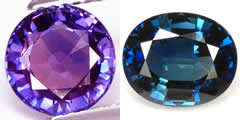
The finest sapphires without thermical treatement are rare and can be obtained from Madagascar (mine Diego Suarez). Some pieces with rounded shapes (that add much more value than other cuttings) can be priced at USD 965 and other pieces whitout thermical treatement and in intense blue (with some green color), 6.33 carats and IF grade clarity can be priced at USD 5575.
It is unusual to find fine sapphires (without thermical treatement) at prices below USD 1000 per carat.
 are the simple processed sapphires since their processing add more value than the original sapphire value. Their price is in the range from USD 10-20 per piece.
are the simple processed sapphires since their processing add more value than the original sapphire value. Their price is in the range from USD 10-20 per piece.The second scale corresponds to the cab sapphires, with few cuttings since their transparency is not enough. Their processing adds more value than their original value. Those can be found in blue and green. Their price tends to be non related to their size. Their price is around USD 10 per carat.


Star sapphires can be found in Thailand with black and golden colors. The blue ones are obtained after processing with titanium. Their prices are USD 10 per carat.
 Next we have the sapphires with multi-faces. The cheapest ones have lower size, additions to the material or are treated with berilum. Their prices ranges from USD 20 per carat and increase according to size and color. Those with more than 1 carat and treated with beryllium (to yield a green color) are priced at USD 75 per carat. Those with yellow and orange-red colors are priced from USD 100 to USD 120 per carat.
Next we have the sapphires with multi-faces. The cheapest ones have lower size, additions to the material or are treated with berilum. Their prices ranges from USD 20 per carat and increase according to size and color. Those with more than 1 carat and treated with beryllium (to yield a green color) are priced at USD 75 per carat. Those with yellow and orange-red colors are priced from USD 100 to USD 120 per carat.Sapphires trated with beryllium are the ones with the highest price increases over the last years.
 The Blue Sapphires that are treated with thermical procedures have prices that depend on their color and transparency. Those sapphires can range from USD 300 for clean pieces of 1 to 2 carats . Prices increase exponentially for sapphires with more than 2 carats. Some are priced at USD 400 per carat and the ones from Madagascar can achieve prices of USD 600 (without additions to the original material).
The Blue Sapphires that are treated with thermical procedures have prices that depend on their color and transparency. Those sapphires can range from USD 300 for clean pieces of 1 to 2 carats . Prices increase exponentially for sapphires with more than 2 carats. Some are priced at USD 400 per carat and the ones from Madagascar can achieve prices of USD 600 (without additions to the original material).
The finest sapphires without thermical treatement are rare and can be obtained from Madagascar (mine Diego Suarez). Some pieces with rounded shapes (that add much more value than other cuttings) can be priced at USD 965 and other pieces whitout thermical treatement and in intense blue (with some green color), 6.33 carats and IF grade clarity can be priced at USD 5575.
It is unusual to find fine sapphires (without thermical treatement) at prices below USD 1000 per carat.